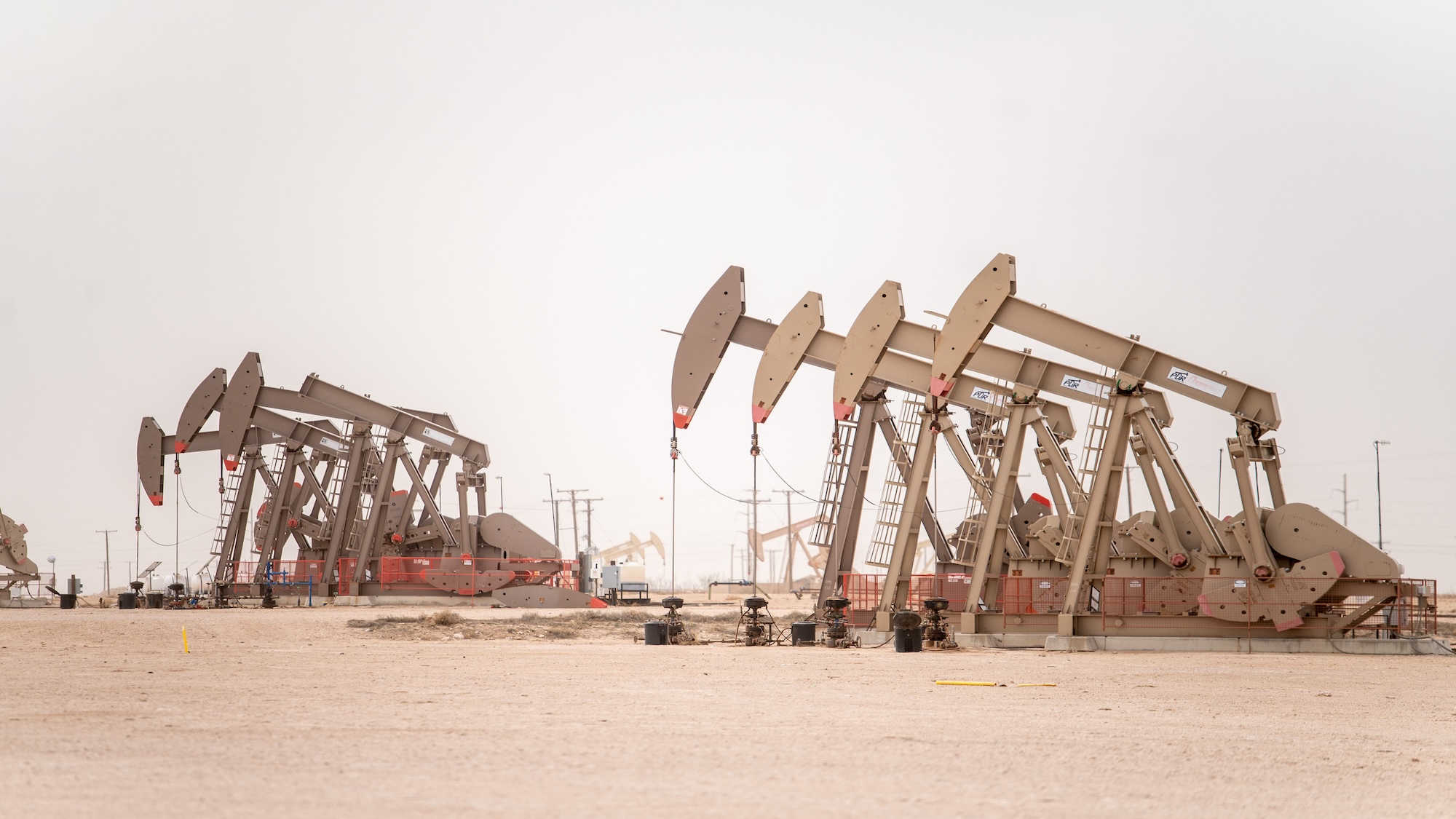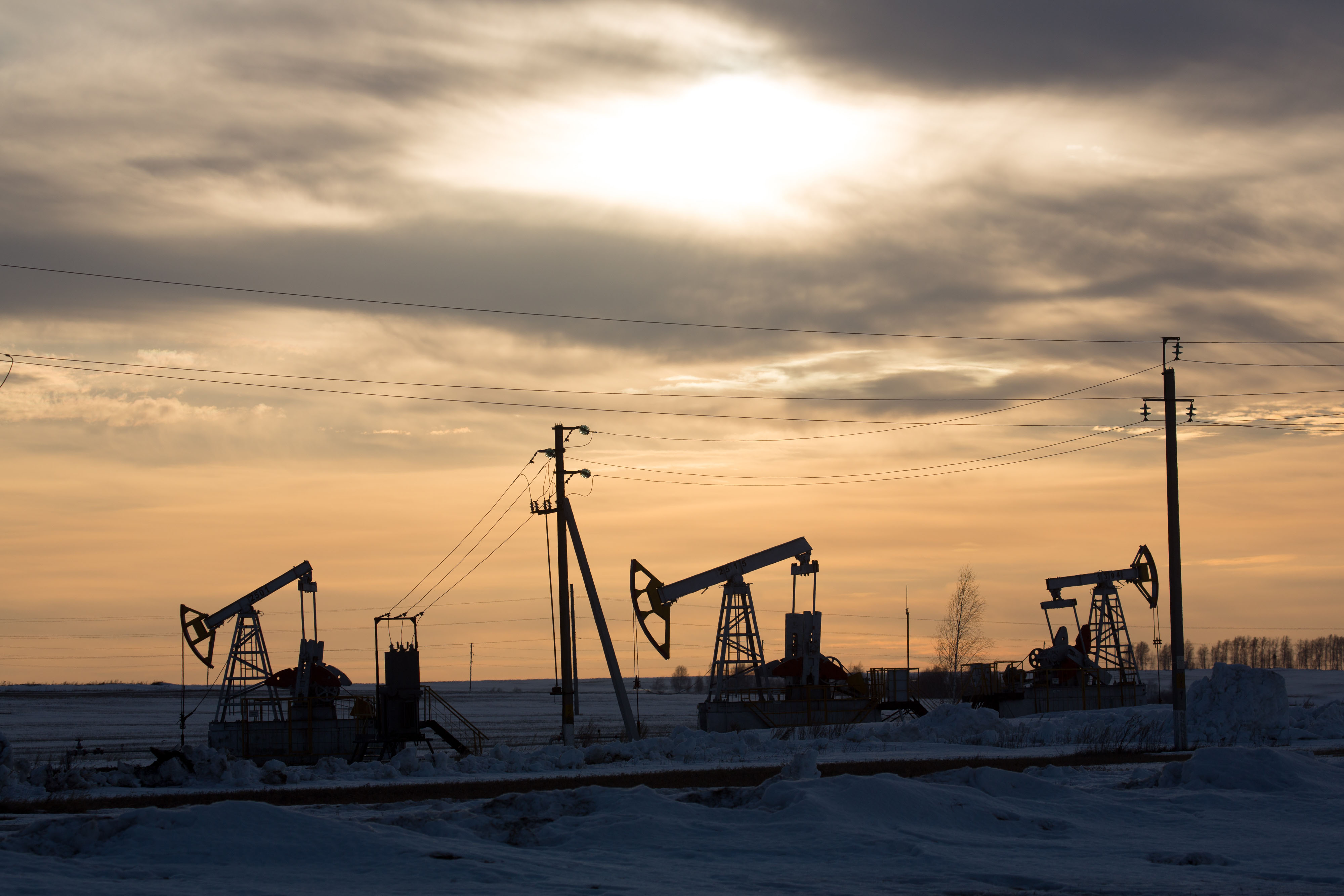Oil price posts two-year highs - but how long can it last?
Brent rose above $59 a barrel this week, its best third-quarter showing since 2004

Oil price 'vulnerable' after Opec shock
7 December
The oil price fell back on Friday to near its low for this year – and since the financial crisis – after the latest Opec meeting ended in acrimony.
Amid dissent among members over a strategy of maintaining high production to squeeze higher-cost rivals, the group conspicuously failed to present any output target at the end of its conference in Vienna.
The Week
Escape your echo chamber. Get the facts behind the news, plus analysis from multiple perspectives.

Sign up for The Week's Free Newsletters
From our morning news briefing to a weekly Good News Newsletter, get the best of The Week delivered directly to your inbox.
From our morning news briefing to a weekly Good News Newsletter, get the best of The Week delivered directly to your inbox.
Reuters says this is fuelling fears in some quarters that unconstrained production will worsen the already record supply glut which is depressing prices.
Having enjoyed a brief relief rally on Thursday, when a fall in the dollar benefited all commodities traded in the currency, international benchmark Brent crude fell two per cent to less than $43.
City AM notes this is within striking distance of its low in August - and the price has since edged down again this morning to $42.80.
With Opec not likely to consider its output ceiling - which had been set at 30 million barrels a day - until next June, after Iran is likely to have emerged from its sanctions regime to boost its own exports, there is a real chance of oil falling further in the short term.
A free daily email with the biggest news stories of the day – and the best features from TheWeek.com
Georgi Slavov of Marex Spectron said Brent crude could fall below $40 a barrel. Other analysts have discussed a price as low as $35 or $30 by the spring, while Goldman Sachs has raised the prospect of a bottom as far down as $20.
The low price is hurting companies and countries around the world that rely on oil revenues. Notably a number of Opec members are struggling with large budget deficits and gulf states are reportedly pulling billions of pounds from investment funds to cover gaps in spending.
According to the Financial Times, at least $19bn has been withdrawn from fund managers this year alone. This figure could even rise to more than $50bn, calculations by JP Morgan suggest, once confidential arrangements are factored in.
Oil price: why petrol prices won't go below £1 a litre… yet
04 December
A fall of nearly 10 per cent in the oil price in November, coupled with seasonal discounts, saw petrol and diesel prices in the UK continue to tumble.
Motoring organisation RAC revealed that the average price for a litre of diesel at UK forecourts fell to 109.5p on 30 November, the lowest level since December 2009.
With the oil price looking set to remain low, the RAC's Simon Williams said the organisation would like to see the sub-£1 litre being offered more widely on a non-promotional basis. But there are four factors that make that unlikely – at least for now.
1. Prices would need to go lower
While the November fall looks sharp, the price of international benchmark Brent crude has actually been in a narrow range between the mid-$40s and $50 for some months.
It's twice touched lows around $43 a barrel since August but immediately bounced back – as it did again this week. It is currently at a little below $44 a barrel in London.
With oil relatively stable, there would have to be a marked drop to bridge the gap between where petrol is now and the £1 a litre RAC wants to see.
2. Wholesale costs are not falling
The Times reported last month that the wholesale costs charged by refiners have actually been increasing slightly, despite the falling oil price.
It cited AA figures showing that, in January, Brent was $47 a barrel and the wholesale price of a tonne of petrol was $470. In November, "the price of a barrel of Brent fell to $44 but wholesale price has risen to $480 per tonne".
AA is not happy about this, but with exploration revenues hit hard by a price slump nobody expected to persist for this long, the increases in 'downstream' prices are probably more a case of survival than profiteering. Charges are therefore unlikely to fall in the near future without another big slip in the main oil price.
3. Currency movements
How the oil price translates into petrol pump charges also goes through another filter: currency movements. The pound is currently weak against the dollar – it fell two per cent in November – which means it effectively costs more to import each barrel, wiping out a lot of the gain from the falling oil price.
With the Federal Reserve poised to raise US interest rates, which is likely to give the dollar another leg up, this dynamic won't change soon.
4. Petrol duty increase
Looking a little further ahead, petrol duty could increase next year after a long freeze by the Chancellor.
His Autumn Statement documents revealed Treasury takings from petrol will increase 2p a litre from April, says the Daily Mail, meaning a hike is on the cards that makes it harder to see how the litre price could get to £1.
Why this could change
As noted, all of this depends on oil not falling substantially lower. Many analysts have said they reckon the oil price is already unsustainably low – so a further big dip would be unlikely.
But the Times notes that hopes for a production cut to help ease oversupply and support prices at an Opec meeting today are highly unlikely to be met.
The output glut is enormous, and with Iran likely to boost exports significantly early next year, there are some suggestions of an impending crash to clear out the market that would send oil down to a 'cost price' as low as $20.
Oil price hits six-year low ahead of Opec meeting
3 December
Claims that the oil price had not reached its low were dramatically vindicated yesterday when the international benchmark fell to its lowest level in nearly seven years.
Brent crude oil tumbled ahead of a meeting of Opec later this week at which it is expected the cartel will hold to its policy of high production – and amid the latest evidence of the consequent global supply glut.
MarketWatch notes the US energy watchdog reported its tenth straight week of reserves increases at a time when domestic stockpiles are at an 80-year high and full tankers are queuing up at ports.
The Energy Information Administration also reported that US output grew slightly to 9.2 million barrels, confounding expectations that brutally low prices would reduce shale production.
Brent fell 4.4 per cent to around $42.50 in London, the lowest since March 2009. It is hovering around $43 this morning. US benchmark West Texas Intermediate also plummeted by 4.6 per cent to below $40 yesterday, only marginally above a multi-year low reached in August.
The next major move in the oil price will be a result of a meeting of Opec nations in Vienna on Friday.
Some are hoping Saudi Arabia will reduce supply to help support prices under lobbying from fellow members, who are feeling the effects on their oil revenue-dependent budgets. The consensus, however, is that it will not do so as it remains distrustful that other non-Opec countries will follow suit.
The Financial Times says one senior Opec official revealed the de facto leader would cut output as long as it is "supported by countries both inside and outside the cartel".
But this seems to set a "high bar for a deal that is unlikely to be met by the time of Friday's meeting", with Russia having recently dismissed output cuts and increased production to record levels, and with Iran refusing to discuss the issue.
Iranian export increases, as and when sanctions are lifted, are seen as critical to its economy and a key reason that many analysts believe the oil market may not yet find a firm floor until the first half of 2016.
Oil price will not hit bottom until early 2016
2 December
The oil price may be rooted 60 per cent below its peak in the summer of last year and at painful, unprofitable levels for most production - but the worst could still be to come.
A survey of analysts and investors by CNBC has found only 21 per cent believe the oil price bottomed out this year, when US benchmark West Texas Intermediate closed as low as $38 a barrel and its international counterpart Brent crude hit $42.
The largest share, 46 per cent, reckon the market will bottom out in the first half of 2016, when Iranian production will return to the market after international economic sanctions are lifted. Some observers, such as Goldman Sachs, have openly discussed prices falling as low as $20 a barrel.
"Oil's turmoil will continue," Daniel Yergin, Pulitzer Prize-winning author and vice-president of analyst IHS, writes.
Yergin adds: "Assuming the nuclear sanctions are lifted on Iran in late winter or spring, [Iran] could bring what we currently estimate to be another 400,000 to 600,000 barrels of oil a day within several months.
"Iran's oil minister pegs the number higher — around a million barrels per day."
This will add to a supply glut that shows no sign of abating. In fact, prices dipped on Tuesday as the American Petroleum Association reported another increase in oil reserves that confounded earlier predictions.
Reuters says the API's estimate showed a 1.5 million-barrel build last week which, if confirmed in official statistics later today, would mark the ninth consecutive week of growth at a time when domestic reserves are already nudging an 80-year record.
Brent dipped 0.5 per cent to a little above $44 a barrel, while WTI fell slightly more sharply to $41.50 a barrel.
While an inventory rise in today's data will lead to fresh downward pressure, Ben Le Brun, market analyst at Sydney's OptionsXpress, said the market was currently "skittish" and likely to "be very range-bound" this week, ahead of a meeting of the Opec cartel this Friday.
Many in the market are hoping Saudi Arabia will follow up its hints of a production slowdown to support prices, as several of its co-members struggle to balance their eviscerated budgets. But the general consensus is that there will be no policy change from the meeting.
The percentage of those polled by CNBC that reckon production will be cut? Zero.
Oil price could rise on 'ECB wild card' – but bear trend to continue
1 December
The oil price steadied yesterday as the US dollar took a breather from its relentless upwards charge.
Having come close to a 13-year high, the greenback dipped against rival currencies yesterday afternoon and remains slightly lower.
International benchmark Brent crude rose two per cent initially, before settling slightly lower in London and then bouncing back again overnight in Asia. The net result was that it remains largely unchanged for the week so far, at a little below $45 a barrel.
US benchmark West Texas Intermediate is similarly weak and largely unchanged at $42 a barrel. Both fell around 10 per cent in November and are at recent lows just $2 or so above the six-year nadir reached earlier this summer.
Where oil will go next is a question of contrasting short and long-term dynamics.
This week it is likely to continue to be driven, like other commodities, by currency movements, as the European Central Bank prepares to unleash further monetary stimulus and a jobs report in the US on Friday could signal the Federal Reserve moving in the opposite direction.
"If we saw selling of the dollar and buying of the euro, it could support oil prices and give us a bit of a rally," Ric Spooner, chief market analyst at Sydney's CMC Markets, told Reuters. "It's really a bit of an ECB wild card at the moment."
Longer term, the assumed trend is more familiar: lower prices caused by oversupply
Reuters notes that US output is largely unchanged, Opec exports rose in November and that supply is outpacing demand, which remains weaker than expected, by as much as 2.5 million barrels a day
Even if a slight fall in US crude oil reserves is reported for the first time in nine weeks in the latest data due tomorrow, this will not fundamentally alter the bearish picture. "The prospects for demand-growth are not large enough to go into the supply overhang," said Spooner.
This explains why a panel of 29 economists have lowered their forecast for average oil prices next year for the sixth consecutive month.
Brent is predicted to be $58 a barrel through the year, down from the $71 predicted in May. With most expecting prices to recover more strongly in the final months of 2016, this could indicate a further fall in the months ahead.
One factor that could change this picture radically is a meeting of the Opec cartel this Friday. There is not expected to be a change to its policy of high production, but if Saudi Arabia does perform a surprise U-turn then prices may move sharply higher.
Oil price falls and is set for 'volatile' week
30 November
The oil price has fallen back from the already weak level at which it had briefly stabilised, at the outset of a week that analysts say is likely to be beset by volatility.
The falls come amid ongoing concern over the ongoing supply glut in the global oil market, but were triggered by the latest rise in the resurgent dollar.
The greenback hit a seven-month high against the euro and is strong against a basket of global currencies, making oil (and other key commodities) expnsive for foreign buyers, weighing on demand.
A major jobs report is due on Friday that could intensify this pressure. The Federal Reserve has made the employment market its key determinant on whether to increase interest rates at its next meeting in a couple of weeks, meaning a positive report will increase speculation that rates could be hiked for the first time in nearly a decade.
The data will cause "huge volatility" in the dollar, analysts at Singapore-based brokerage Phillip Futures Pte Ltd wrote in a note, according to Reuters. "This should in turn cause some volatility to oil prices depending on how the USD strength plays out."
Uncertainty for oil is also likely ahead of a critical meeting of the Opec cartel, also on Friday. Saudi Arabia, the 13-nation bloc's de facto leader, has indicated it may be prepared to ease its currently high production to help turn around low prices that are eviscerating the budgets of its members – but the market is split on whether any tangible action will result from the gathering in Vienna this week.
Despite pressure from a number of members, including cash-strapped Venezuela and Iran, and even disquiet within its own ranks, Saudi Arabia is unlikely to do anything to ease supply until at least the middle of 2016, reckons the Wall Street Journal.
This is when Iran's ability to return to the market after international sanctions are lifted – and the effect on prices – will have become clear.
-
 Why is Trump’s alleged strike on Venezuela shrouded in so much secrecy?
Why is Trump’s alleged strike on Venezuela shrouded in so much secrecy?TODAY'S BIG QUESTION Trump’s comments have raised more questions than answers about what his administration is doing in the Southern Hemisphere
-
 Vance’s ‘next move will reveal whether the conservative movement can move past Trump’
Vance’s ‘next move will reveal whether the conservative movement can move past Trump’Instant Opinion Opinion, comment and editorials of the day
-
 Why recognizing Somaliland is so risky for Israel
Why recognizing Somaliland is so risky for IsraelTHE EXPLAINER By wading into one of North Africa’s most fraught political schisms, the Netanyahu government risks further international isolation
-
 How might the Israel-Hamas war affect the global economy?
How might the Israel-Hamas war affect the global economy?Today's Big Question Regional escalation could send oil prices and inflation sky-high, sparking a worldwide recession
-
 Recent mega-mergers could signal a turning point for the US oil industry
Recent mega-mergers could signal a turning point for the US oil industryTalking Point Both Chevron and Exxon have recently spent billions to acquire smaller oil companies
-
 Has Saudi Arabia lost control of oil prices?
Has Saudi Arabia lost control of oil prices?Today's Big Question Kingdom goes it alone to cut production, risking tension with US and reigniting cooling inflation in Europe
-
 US angered by Opec+ oil cut
US angered by Opec+ oil cutSpeed Read Energy prices to rise further as producers slash supply by two million barrels a day
-
 Global oil demand forecast lowered for 2020 and 2021
Global oil demand forecast lowered for 2020 and 2021Speed Read IEA report says jet fuel demand remains the major source of weakness
-
 Are US-Iran tensions flaring again?
Are US-Iran tensions flaring again?In Depth Trump threatens military action over Twitter
-
 Can a deal be struck to raise oil prices?
Can a deal be struck to raise oil prices?In Depth Opec+ will convene today over video link in a bid to boost crude
-
 What do negative oil prices mean?
What do negative oil prices mean?In Depth Perfect storm of oversupply and storage shortages sees producers paying to get rid of US crude